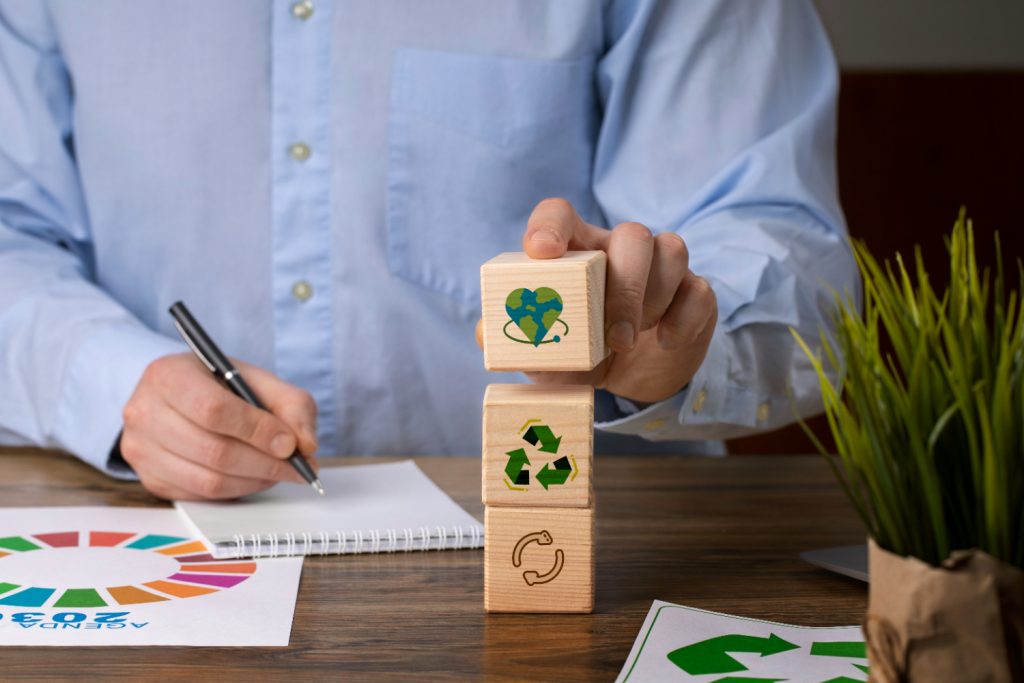The traditional economic model, based on extracting resources, producing, consuming, and discarding, is reaching its limit. This linear system is causing problems such as the overexploitation of natural resources and the accumulation of waste and exacerbates global challenges like climate change and biodiversity loss. In this context, the circular economy presents itself as a sustainable alternative, especially beneficial for small and medium-sized enterprises (SMEs).
What is the circular economy?
The circular economy is a model that seeks to eliminate waste and pollution from the initial design, keep materials and products in use for as long as possible, and regenerate natural systems. This model not only promotes a more balanced relationship with the environment but also offers significant competitive advantages for companies that adopt it.
Key Benefits for SMEs
Implementing strategies based on the circular economy can transform SMEs, allowing them to:
- Reduce costs, thanks to the optimization of resources and production processes.
- Access new markets, due to the increased demand for sustainable and circular products.
- Improve reputation, by strengthening brand value and consumer trust.
- Comply with regulations, as it facilitates compliance with environmental regulations.
- Increase resilience and efficiency, due to less dependence on suppliers and process optimization.
- Retain talent, particularly more committed and motivated personnel for working in a sustainable company.
Challenges faced by SMEs
Undoubtedly, the implementation of the circular economy in companies, particularly in SMEs, is not without challenges. However, there are also concrete actions that allow them to be addressed effectively:
- High initial investment: There are specific grants to facilitate the transition to a circular economy. Establishing strategic collaborations to optimize the costs of measures can also be effective.
- Lack of knowledge and training: Specific training and integration into support networks are fundamental measures in the transition to circularity.
- Internal resistance to change: Staff involvement and effective communication of benefits can mitigate this potential problem.
- Difficulties in the supply chain: The search for alternative suppliers and collaborative networks are key.
- Low initial demand: Marketing actions and customer awareness help overcome this obstacle.
- Impact measurement and monitoring: Establishing clear metrics and using specific tools facilitates evaluating results.
The role of innovation in the circular economy
Innovation is an essential element to accelerate the transition towards a circular economy, offering solutions that reformulate traditional production and consumption processes. The main areas of innovation include:
- Sustainable design: Creating durable and recyclable products.
- Process optimization: Increasing efficiency and reducing waste.
- Waste management: Converting waste into resources whenever possible.
- Circular businesses: Adopting models such as rental, repair, or reuse.
- Digital technologies: Facilitating transformation through advanced tools.
- Collaboration networks: Enhancing cooperation between companies.
Available tools and technologies
With innovation being fundamental for the transition to the circular economy, SMEs have a multitude of tools and technologies available to develop it. Among them, the following could be highlighted:
- INTERNET OF THINGS (IoT): System for connecting objects to the internet or to each other, allowing control of devices from anywhere.
- BIG DATA & DATA ANALYTICS: Technology for analyzing huge volumes of data that are collected, organized, and interpreted for transformation into useful information.
- SUSTAINABILITY SOFTWARE: Software aimed at measuring, analyzing, managing, and reporting specific aspects of sustainability.
- SIMULATION: Tools for virtual representation of products and processes, allowing anticipation of possible problems and process optimization.
- ARTIFICIAL INTELLIGENCE (AI): Combination of algorithms formulated with the purpose of creating machines that present capabilities identical to those of humans.
- EXTENDED REALITY: Combination of real and virtual environments along with human-machine interactions driven by technology.
- ROBOTICS: Design of machines programmed to perform tasks automatically, achieving increased productivity.
- ADDITIVE MANUFACTURING: Construction of 3D objects sequentially in a process of adding layers of material.
- BLOCKCHAIN: Set of technologies for secure, decentralized, synchronized, and distributed recording of digital operations, without third-party intermediation.
- HORIZONTAL AND VERTICAL INTEGRATION: Optimization of information and goods flow in the value chain (horizontal integration) or within the company itself (vertical integration).
The circular economy is not only a necessity to ensure environmental sustainability but also a powerful strategy to strengthen the competitiveness of SMEs. Those companies that bet on this model will be better prepared to face the challenges of the future, while actively contributing to a more balanced and responsible development.
